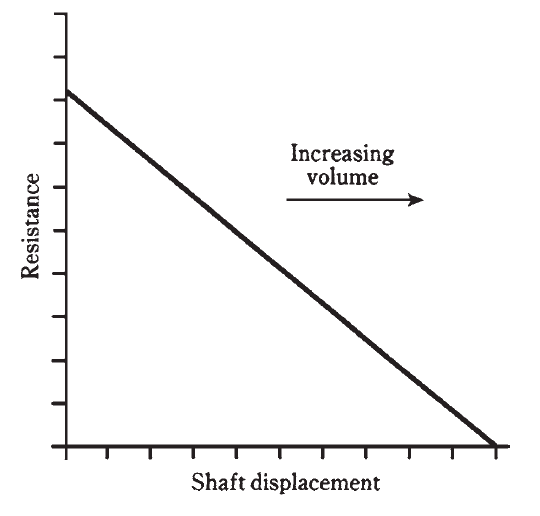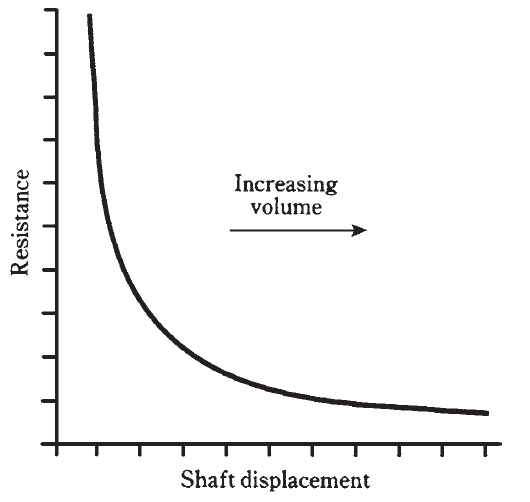
The potentiometer
 المؤلف:
Stan Gibilisco
المؤلف:
Stan Gibilisco
 المصدر:
Teach Yourself Electricity and Electronics
المصدر:
Teach Yourself Electricity and Electronics
 الجزء والصفحة:
106
الجزء والصفحة:
106
 13-4-2021
13-4-2021
 3236
3236
The potentiometer
All of the resistors mentioned are fixed in value. It is impossible to change or adjust their resistances. Of course, their values will change if they overheat, or if you chip pieces of them out, but they’re meant to provide an unchanging opposition to the flow of electric current.
It might have occurred to you that a variable resistor can be made by hooking up a bunch of fixed resistors in series or parallel, and then switching more or fewer of them in and out. This is almost never done in electronic circuits because there’s a better way to get a variable resistance: use a potentiometer.
The construction of a potentiometer is shown in simplified form in Fig. 1. A resistive strip is bent into a nearly complete circle, and terminals are connected to either end. This forms a fixed resistance. To obtain the variable resistance, a sliding contact is attached to a rotatable shaft and bearing, and is connected to a third terminal. The resistance between this middle terminal, and either of the end terminals, can vary from zero up to the resistance of the whole strip.
Some potentiometers use a straight strip of resistive material, and the control moves up and down, or from side to side. This type of variable resistor, called a slide potentiometer, is used in graphic equalizers, as the volume controls in some stereo amplifiers, and in some other applications when a linear scale is preferable to a circular scale. Potentiometers are made to handle only very low levels of current, at low voltage.
Linear taper
One type of potentiometer uses a strip of resistive material whose density is constant all the way around. This results in a linear taper. The resistance between the center terminal and either end terminal changes at a steady rate as the control shaft is turned.
Suppose a linear taper potentiometer has a value of zero to 280 Ω. In most units the shaft rotates about 280 degrees, or a little more than three-quarters of a circle. Then the resistance between the center and one end terminal will increase right along with the number of degrees that the shaft is turned. The resistance between the center and the other end terminal will be equal to 280 minus the number of degrees the shaft is turned. Engineers say that the resistance is a linear function of the shaft position.
Linear taper potentiometers are commonly used in electronic test instruments and in various consumer electronic devices. A graph of resistance versus shaft displacement for a linear taper potentiometer is shown in Fig. 2.

Fig. 1: At A, simplified drawing of the construction of a rotary potentiometer. At B, schematic symbol.
Audio or logarithmic taper
There are some applications for which linear taper potentiometers don’t work well. The volume control of a radio receiver is a good example. Your ear/brain perceives sound level according to the logarithm of its true level. If you use a linear taper potentiometer as the volume control of a transistor radio or other sound system, the level will seem to go up too slowly in some parts of the control range and too fast in other parts of the control range.
To compensate for the way in which people perceive sound level, an audio taper potentiometer is used. In this device, the resistance between the center and end terminal increases in a nonlinear way. This type of potentiometer is sometimes called a logarithmic-taper device.
If the shaft is all the way counterclockwise, the volume at the speaker is zero or near zero. If you turn the shaft 30 degrees clockwise, the volume increases to some perceived level; call it one sound unit. If you then turn the volume 30 degrees further clockwise, the volume will seem to go up to two sound units. But in fact it has increased much more than this, in terms of actual sound power.
You perceive sound not as a direct function of the true volume, but in units that are based on the logarithm of the intensity. Audio-taper potentiometers are manufactured so that as you turn the shaft, the sound seems to increase in a smooth, natural way. A graph of resistance versus shaft displacement for an audio-taper potentiometer is shown in Fig. 3.

Fig. 2: Resistance-vs-displacement curve for linear taper potentiometer.

Fig. 3: Resistance-vs-displacement curve for audio-taper potentiometer.
 الاكثر قراءة في الألكترونيات
الاكثر قراءة في الألكترونيات
 اخر الاخبار
اخر الاخبار
اخبار العتبة العباسية المقدسة


